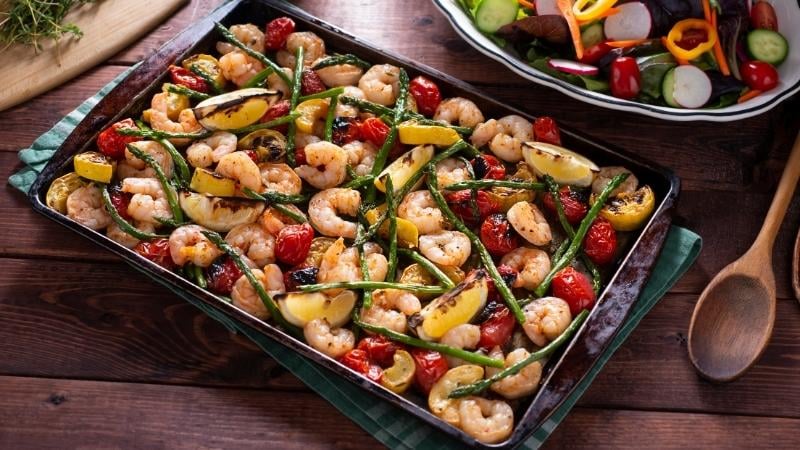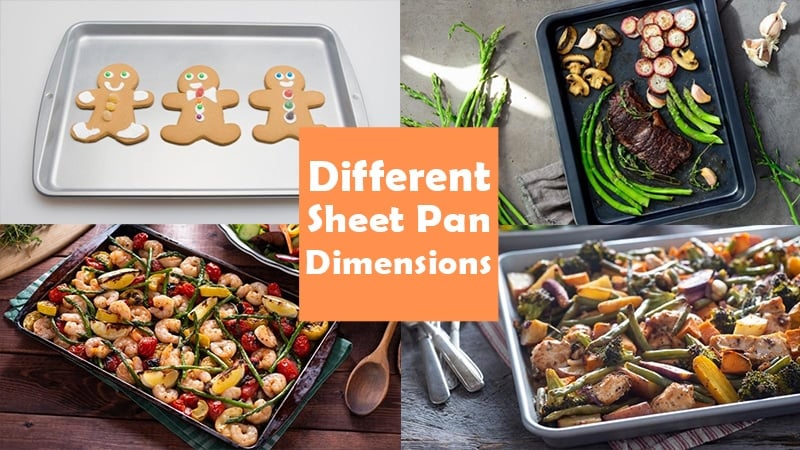With flat baking pans, it’s easy to become bogged down in the variety of options and end up confused. Sheet pans, baking sheets, and cookie sheets are all examples of cooking utensils. The list is endless!. Although this article will focus on sheet pans, their various types, their dimensions, and any other crucial information you need to know about them.
A sheet pan is a rectangular baking pan with a high rim and a big flat baking surface. There are three standard sizes available: full sheet pans, half-sheet pans, and quarter sheet pans.
The dimensions of a full-sheet pan are 26 inches by 18 inches, with one-inch-high sides. A half-sheet pan is roughly 1 inch tall, and 18 by 13 inches in size. A quarter sheet pan is usually 13 by 9 inch
Sheet pans are popular in both commercial kitchens and home ovens, and well-made ones are heavy-duty enough for daily use.
In terms of versatility, sheet pans are hard to beat. They’re just as good at roasting veggies as they are at melting cheese on nachos in the oven to the table. To produce crispy bacon, you can either lay a cooling rack inside a sheet pan and set the oven temperature to broil, or you can use a sheet pan with a cooling rack.
Different types of sheet pans, their dimensions, and usages
Full sheet pan

The dimensions of a full-sheet pan are 26 inches by 18 inches, with one-inch-high sides. They’re generally too huge for everyday use in the home, and many ovens simply won’t accommodate them.
Catering companies and some restaurants use these as their workhorse pans (but they’re a bit large for most restaurant kitchens, too). As a pantry organizer, most kitchens can benefit from a complete sheet pan.
Half sheet pan

Just as the name implies, a half sheet pan is exactly half the size of a full sheet pan.
A half sheet pan can be made by cutting a full sheet pan in half lengthwise and then turning one of the sides sideways (with one rimless side, of course). With a height of roughly 1 inch, half sheet pans are typically 18 by 13 inches in size.
Those with smaller ovens or who only need to roast a few vegetables or broil a few salmon filets may prefer to use half-sheet pans instead of full sheet pans.
Quarter sheet pan

A quarter-sheet pan is the result of halving a half-sheet pan. It’s a 13-by-9-inch sheet, as you may have guessed. When preparing meals for a single-family or small group, this is the pan of choice.
It has the same functionality as a half sheet but is designed for use by far fewer people. Since full and half sheet pans are too bulky to fit into most refrigerators, this pan becomes ideal for that purpose.
You can also use it for other purposes such as baking in the toaster oven, and freezing batches of cookies before transferring them to plastic freezer bags.
Jelly Roll
Typically measuring 15.5-by-10.5 inches, jelly roll pans fall in between a half-sheet and a quarter-sheet pan in size. They’re the kind of pans you’ll find in most supermarkets for cheap prices, but high-quality ones can be bought for a slightly higher price. The pan is named after Jello Rolls or Swiss Roll Cakes and these delicacies cannot be produced without them.
There’s no easy way to convert baking recipes that specifically call for a jelly-roll pan because the volume of a quarter or half sheet differs substantially from this in-between pan. You can use jelly-roll pans to roast veggies in the same way you would use a quarter-sheet pan, but they’ll give you a little more room to spread out the food.
Cookie sheet

One side of a cookie sheet is raised, and the other three sides are flat, making it ideal for making cookies. In theory, the lack of edges of a cookie sheet helps air to move around baking cookies more readily, resulting in more uniformly cooked cookies.
It’s also easy to slide a spatula beneath the cookies so that they can be transferred to a cooling rack more quickly.)
When roasting cooking or veggies, you don’t want any browning at all on the bottom of the vegetables or the cookies, which is why cookie sheets are commonly insulated. Bake cookies and free-form bread loaves on a cookie sheet instead of roasting meat or anything else that can leak juices.
Cookie sheets aren’t necessarily the only pan for making cookies, however, they are the best option for this purpose.
Sheet pans are almost essential in every kitchen. They are great for making a variety of recipes, both sweet and savory, and the essence of the different sizes discussed above is for you to know how to choose the one that is the most suitable for your needs; because pan performance varies depending on the material and other conditions, and having the proper pan for the job might save time.
The dimension of stuff has been an interest of mine ever since I was a child. What I believe is most fascinating about the dimension of stuff is how extremely long, tall and wide some objects are both on earth and in the universe.

